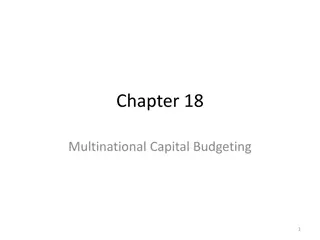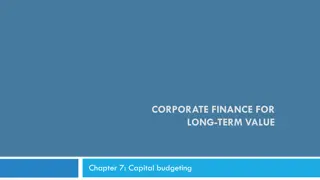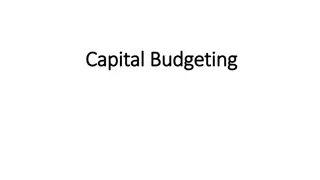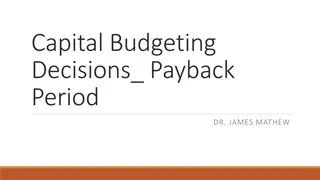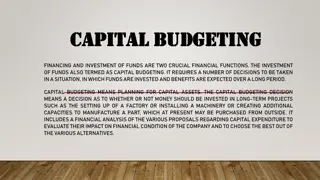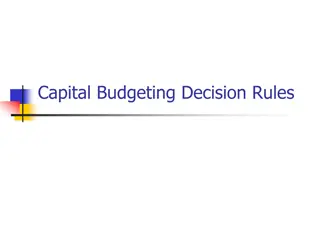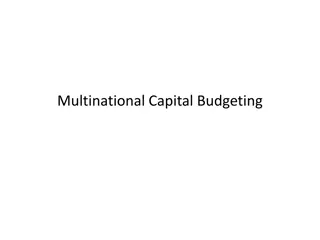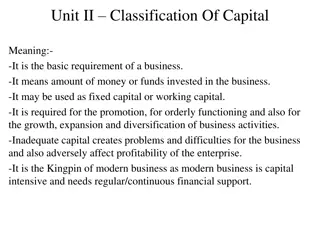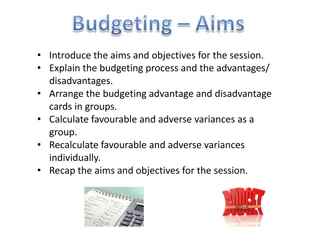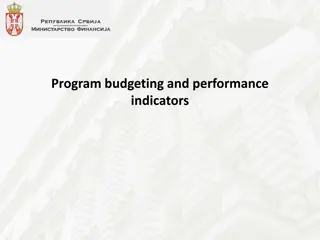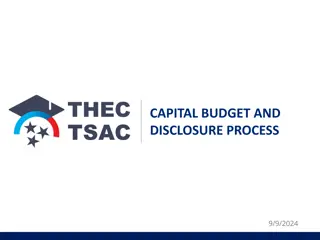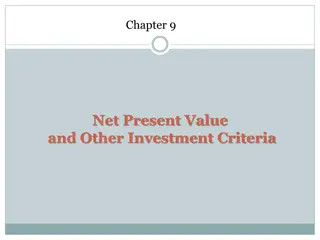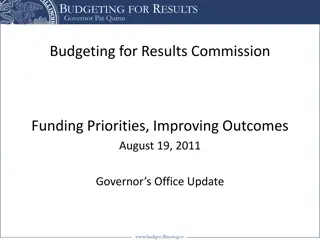Effective Budgeting and Forecasting Practices for Improved Resource Allocation
Understand the key differences between budgeting and forecasting, why they are essential, and where these processes are carried out. Learn about historical forecasting methods, the introduction of the Budgeting and Forecasting Tool (BFT) for increased efficiency, and the importance of BFT reporting
2 views • 31 slides
CAPITAL STRUCTURE
Capital structure refers to the mix of a firm's capitalization, including debt, preference share capital, equity share capital, and retained earnings. Choosing the right components of capital is crucial based on the organization's function and risk level. Different patterns/forms of capital structur
1 views • 6 slides
Theories of Capital Structure and their Applications
The theories of capital structure explore the relationship between debt and equity in a firm's financing decisions. By optimizing the mix of debt and equity, a company can minimize its cost of capital and maximize its value. The Net Income Approach highlights the benefits of using debt to lower the
1 views • 7 slides
Factors Influencing Economic Growth: Human Capital and Capital Goods
Factors such as investment in human capital, capital goods, natural resources, and entrepreneurship play a crucial role in determining a country's economic growth. Human capital encompasses the skills and abilities of workers, while capital goods are the tools and equipment used to produce goods and
2 views • 28 slides
Challenges in Multinational Capital Budgeting
Multinational Capital Budgeting extends the domestic analysis to evaluate foreign projects, focusing on cash flows, risk adjustments, and real option analysis. It involves complexities such as distinguishing parent cash flows from project cash flows, dealing with differing tax systems, political con
3 views • 15 slides
Effective Capital Budgeting Strategies for Long-Term Value Creation
Understanding the capital budgeting process is crucial for selecting investment projects that align with long-term value creation goals. This involves calculating cash flows, discount rates, and valuation methods to evaluate projects based on financial, social, and environmental dimensions. Estimati
0 views • 31 slides
Financial Fitness for Life - Chapter 8: Managing Your Money
Explore key budgeting terms, learn about budgeting, and evaluate budgeting decisions. Understand elements of a monthly family budget, apply cost-benefit concepts, and discover national and state standards related to budgeting. Access activities and resources for effective money management.
0 views • 37 slides
Mutual Capital Investment Fund: Addressing Capital Needs in the Insurance Community
Mutual Capital Investment Fund, LLC, aims to provide capital to mutual insurance companies facing capital needs without converting to stock form or selling minority interests. Led by Mutual Capital Group, the Fund seeks commitments up to $100 million and offers a unique investment opportunity for mu
0 views • 8 slides
Understanding Capital Budgeting for Long-Term Financial Planning
Learn about capital budgeting to make strategic financial decisions by analyzing cash flow, evaluating project viability, estimating net present value, determining internal rate of return, and more. Explore examples of capital budgeting decisions and investment opportunities with a focus on the time
0 views • 43 slides
Budgeting Essentials Presented at CHUSS Heads of Departments Workshop
Budgeting is a vital managerial process involving designing, implementing, and operating budgets to plan, coordinate, and ensure effective control over organizational activities to achieve objectives. This process includes incremental, activity-based, value proposition, and zero-based budgeting meth
2 views • 13 slides
Understanding Capital Budgeting Decisions and Investment Strategies
Capital budgeting decisions involve long-term investments in assets to generate anticipated future benefits, with high risk and long periods between outlay and return. They are crucial for firm growth, asset allocation, and risk management. Different types of investment decisions like expansions, di
1 views • 13 slides
Features of an Appropriate Capital Structure and Optimum Capital Structure
While developing a suitable capital structure, the financial manager aims to maximize the long-term market price of equity shares. An appropriate capital structure should focus on maximizing returns to shareholders, minimizing financial insolvency risk, maintaining flexibility, ensuring the company
3 views • 5 slides
Gender-Responsive Planning and Budgeting for Climate Change Resilience
Planning and budgeting processes from a gender perspective are crucial for achieving gender equality and addressing climate change effectively. Gender mainstreaming in planning involves considering the specific needs and capabilities of men and women in national programs. Budgeting with a gender per
1 views • 18 slides
Understanding Capital Budgeting in Financial Management
Capital budgeting involves crucial financial functions related to investing and financing funds for long-term projects. It entails making decisions on investing in capital assets and evaluating proposals to determine their impact on a company's financial condition. The process requires careful analy
0 views • 14 slides
Investment Decisions and Capital Budgeting Overview
Investment decisions and capital budgeting are crucial processes in which firms assess the acquisition of fixed assets. This involves evaluating projects based on various methods such as out of pocket commitment, pay back period, and average annual rate of return. The significance of investments lie
0 views • 44 slides
Understanding Risk, Cost of Capital, and Capital Budgeting in Corporate Finance
Explore the concepts of risk, cost of capital, and capital budgeting in corporate finance, including the Capital Asset Pricing Model (CAPM), cost of equity, beta estimation, and cost of capital. Learn how to reduce the cost of capital and understand the impact of reducing the Weighted Average Cost o
0 views • 20 slides
Essential Capital Budgeting Decision Rules
Recommended capital budgeting decision rules include NPV analysis for assessing project feasibility and IRR for evaluating project returns. NPV helps in choosing projects with positive value, while IRR calculates the project's internal rate of return. Understanding these rules aids in making informe
1 views • 25 slides
Understanding Capital Budgeting Process and Estimating Cash Flows
The capital budgeting process involves identifying and selecting investment projects with returns extending beyond a year. It includes generating proposals, estimating after-tax incremental cash flows, and selecting projects based on value-maximizing criteria. Investment project proposals are classi
0 views • 31 slides
Understanding Multinational Capital Budgeting Process
Multinational capital budgeting involves evaluating international projects by analyzing future cash flows, net present value, and initial investment outlay. Factors like exchange rate fluctuations, inflation, and financing arrangements need careful consideration. Proper use of this process helps ide
1 views • 64 slides
Understanding Budgeting and Budgetary Control
Budgeting and budgetary control are essential financial management tools used by businesses to plan, coordinate, and control their operations and resources. A budget is a short-term financial plan that serves as a guide to achieving predetermined targets, while budgeting involves the process of prep
0 views • 10 slides
Understanding the Classification and Importance of Capital in Business
Capital is crucial for businesses, whether for promotion, functioning, growth, or expansion. It can be classified as promotional, long-term, short-term, or development capital. Factors influencing capital requirements include business activity, size, product nature, technology, business cycle, and l
2 views • 13 slides
Capital Gains and Assets Overview in Income Tax Law and Accounts
This content provides an overview of capital gains and assets in income tax law and accounts, covering topics such as types of capital assets, assets not considered capital assets, kinds of capital assets (short-term and long-term), transfer year of chargeability, computation of capital gains, and c
0 views • 15 slides
Understanding Budgeting Objectives and Process in Business
Budgeting plays a crucial role in business planning by providing a financial roadmap for achieving objectives. This session covers the aims and objectives of budgeting, the budgeting process, advantages and disadvantages, and how variances are calculated. The content emphasizes setting objective-dri
0 views • 24 slides
Program Budgeting and Performance Indicators in Government Budgeting Process
Program budgeting involves designing methodology, cooperation with budget users, establishing connections with strategic documents, planning, approval, and execution of budgets to enhance transparency, prioritization, and spending performance in government budgeting. It aims to improve understanding
3 views • 30 slides
Understanding Capital Budgeting Techniques and Project Evaluation
Explore the world of capital budgeting with a focus on project evaluation techniques. Learn about payback period, internal rate of return, net present value, and profitability index through a practical example of evaluating a new project for Basket Wonders. Discover how these methods can help in dec
1 views • 48 slides
Understanding Capital Budgeting Techniques
Capital budgeting techniques are essential for making informed investment decisions. Conventional methods like Payback Period offer simplicity and risk assessment, while Discounted Payback Period accounts for time value of money. Each method has its advantages and disadvantages, highlighting the imp
0 views • 14 slides
Peer Learning and Exchange: Advancing Gender-Responsive Climate Budgeting
Countries recently converged to discuss integrating gender and climate change into national planning and budgeting. With 16 countries and 82 government officials participating, there was a focus on gender-responsive budgeting experiences and the emerging field of gender-responsive climate budgeting.
1 views • 5 slides
Improving Public Housing through Participatory Budgeting and Capital Funding
Explore the challenges faced by NYCHA, the largest public housing authority in the US, such as decreased operating funds and city capital-funded project requirements. Learn the distinction between capital and operational funding, eligibility criteria for capital projects, and recommended improvement
0 views • 10 slides
Fiscal Year 2022 Capital Budget Presentation Overview
In the presentation to the Board of Finance, the Capital Committee outlines the Fiscal Year 2022 draft capital budget, emphasizing the importance of the Capital Improvement Program and the history of the capital program investments. The proposed budget addresses the critical need for reinvestment in
0 views • 11 slides
Understanding the Capital Budgeting and Disclosure Process
This content provides a comprehensive overview of the capital budgeting and disclosure process, focusing on fiscal years, budget terms, and the sequential steps involved in the capital budget process. It explains the timeline from the Governor's capital budget release to the final approval by the go
2 views • 23 slides
Development of Methodologically Robust Agricultural Capital Stock Statistics by FAO
In November 2015, the Food and Agriculture Organization of the United Nations (FAO) initiated a project to enhance Agricultural Capital Stock statistics, focusing on inclusive and efficient agricultural and food systems. The project involves developing methodologies for measuring capital stock and m
0 views • 38 slides
Estimating the Cost of Capital in Corporate Finance
Explore the process of estimating the cost of capital essential for discounted cash flows models in corporate finance. Learn how to determine the cost of debt, equity capital, and the Weighted Average Cost of Capital (WACC) by combining different sources of financing. Gain insights into capital stru
0 views • 59 slides
Budgetary Planning and Control in Financial Management
Exploring the concept of budgetary planning and control, this module covers different budgeting approaches such as Incremental Budgeting, Zero-Based Budgeting, and Activity-Based Budgeting. It discusses the purpose of budgets, budgetary control processes, typical variances in road construction, and
0 views • 17 slides
Understanding Capital Budgeting: Evaluating Investment Criteria
Explore key concepts in capital budgeting such as net present value, payback period, internal rate of return, and more. Learn how to assess investment decisions based on criteria like time value of money, risk, and value creation for the firm. Evaluate advantages and disadvantages of different decis
0 views • 41 slides
Understanding Net Investment in Capital Assets and Its Importance
Net Investment in Capital Assets is a critical component of an entity's financial position, reflecting the value of capital assets owned. It represents the portion of the net position that is not spendable as it is invested in assets. Calculating Net Investment in Capital Assets involves subtracting
1 views • 17 slides
Institutionalizing Performance Budgeting: Key Institutions and Actors
This presentation by Teresa Curristine from the IMF in Colombia discusses essential building blocks for Performance Informed Budgeting (PIB), designing PIB systems, incentivizing performance improvement, engaging political leadership, and dispelling myths regarding performance budgeting. It emphasiz
0 views • 26 slides
Understanding Venture Capital: Key Concepts and Regulations
Venture capital is a form of financing provided to startup companies with high growth potential. It involves high risk and requires a long-term horizon, often coming in various forms like equity, conditional loans, and participation in management. The process includes stages such as seed capital, ex
0 views • 10 slides
Understanding Capital Adequacy Ratio (CAR) in Banking
Capital Adequacy Ratio (CAR) is a crucial metric in banking that measures a bank's capital against its risk. Also known as CRAR, it enhances depositor protection and financial system stability worldwide. The CAR formula involves dividing a bank's capital by its risk-weighted assets, comprising tier
0 views • 7 slides
Understanding Budgeting Process in Organizations
Budgeting is crucial for organizations to allocate financial resources effectively. In the public sector, it's a legal document requiring changes to go through political procedures. Private sector and NGOs use budgeting for planning, but frequent changes may indicate poor planning. Budgeting helps o
0 views • 37 slides
Governor Pat Quinn's Budgeting for Results Initiative Overview
Governor Pat Quinn implemented the Budgeting for Results (BFR) initiative to reform Illinois' budgeting process, align programs with citizens' priorities, and enhance accountability through performance management. The initiative focuses on outcome-based budgeting, involving strategic planning, evalu
0 views • 13 slides




